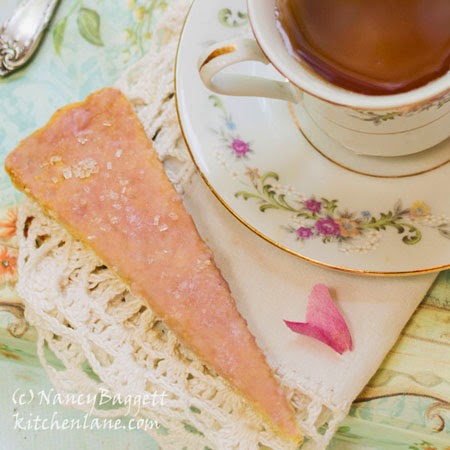
| Petticoat Tails Shortbread with Rose Water Icing |
Author: Nancy Baggett
A batch of these makes an impressive gift or a highly memorable addition to a tea table. Of course, another alternative–which I highly recommend–is just keeping them around to nibble on whenever you have a cup of tea or coffee.
Ingredients
- 1 cup (2 sticks) cool and barely firm unsalted butter, cut into chunks
- ⅓ cup granulated sugar
- 2 teaspoons rose water, plus more if needed
- Generous ¼ teaspoon fine table salt
- 1¾ cups unbleached all-purpose white flour
- Icing and Garnish
- ½ cup powdered sugar, sifted after measuring if lumpy
- 1 teaspoon fresh lemon juice
- 1 to 2 teaspoons rose water, as needed
- Very tiny dot of food color (preferably botanical), optional
- Coarse crystal sugar for garnish, optional
Instructions
- Place a rack in the middle of the oven; preheat to 300 degrees F. Set out a 9- to 10-inch fluted tart pan or 10-inch pie plate. (If using a pie plate, line it with foil that overhangs 2 inches on opposing sides.) Set out a large (ungreased) baking sheet.
- Combine the butter, granulated sugar, rose water and salt in a large bowl. With a mixer on medium speed, beat about 2 minutes or until well blended and lightened in color, scraping down the bowl as needed. On low speed, beat in the flour until evenly incorporated. If the mixer motor labors, work in the last of the flour with your hands, but for tenderest shortbread keep the mixing to a minimum. If the dough is dry and crumbly work in a small amount of rose water.
- Press the dough evenly into the tart pan or pie plate: If using the tart pan finish the dough edges by pushing it into the fluted indentations; be sure the dough edge is evenly thick all around. If using a foil-lined pie plate, press the dough evenly into the bottom and out to the edges until it is evenly thick at the perimeter. If necessary smooth the dough surface by laying a sheet of wax paper over top, then smoothing out and pressing down with your fingertips. With a table knife, carefully cut the dough into quarters, then cut each quarter into 4 or 5 wedges. Set pan on larger baking sheet.
- Bake for 45 to 50 minutes, or until the shortbread is fragrant, lightly colored all over and not quite firm when pressed in the center top. Let the pan cool for about 10 minutes on a wire rack.
- Meanwhile ready the rose water icing: In a small deep bowl, thoroughly stir together the powdered sugar, lemon juice, and enough rose water to yield a thin, smooth, fairly runny icing; add more rose water or more powdered sugar as needed. Add in a tiny dot of food color if desired. Using a pastry brush (or substitute a damp paper towel) dip into the icing and lightly and quickly spread it out evenly over the shortbread top; the layer will be thin. Immediately sprinkle crystal sugar over the top, if desired. Carefully retrace the cuts, then let the shortbread stand until completely cooled before lifting out and serving wedges with a long-bladed spatula. Store the wedges reassembled into a round in a large flat box or in regular storage container if preferred. Keep airtight at room temperature for up to 2 weeks. Freeze airtight for up to 2 months.
Notes
Tip: The rose water flavor is delicate. If you have your heart set on a more noticeable rose character, you can add a few drops of rose extract to the dough and a drop to the icing. But use a light hand–it’s potent!
Tip: It’s important to use a tart pan or pie plate with the specified diameter of 9 to 10 inches. In a larger pan, the dough will spread out too much and the wedges will be too thin and fragile (and prone to breaking). In a smaller pan, they will be a little to chunky and hard to bake through in the middle, though lowering the heat to 275 degrees F and baking them 5 to 10 minutes extra will likely solve that problem.
Tip: It’s important to use a tart pan or pie plate with the specified diameter of 9 to 10 inches. In a larger pan, the dough will spread out too much and the wedges will be too thin and fragile (and prone to breaking). In a smaller pan, they will be a little to chunky and hard to bake through in the middle, though lowering the heat to 275 degrees F and baking them 5 to 10 minutes extra will likely solve that problem.
Recipe by KitchenLane at http://kitchenlane.com/2014/09/scottish-rose-water-shortbread-with-rose.html